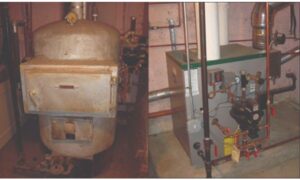An industrial ammonia refrigeration system is used for large-scale operations. Ammonia is a very-efficient refrigerant, and one of the most cost-effective refrigerants for commercial use. It is not used in modern home refrigeration, anymore, because its fumes can be toxic. Ammonia is highly energy efficient and natural refrigerant which is widely adopted, and utilised by the industry. Its natural refrigerant properties don’t cause any ozone depletion not does it contribute to global warming.
Most people are used to using refrigeration systems that use CFCs, or even older systems that use Freon. Due to the environmental impact of these chemicals, and their cost, they are not the ideal choice in industrial environments.The refrigerated warehouse industry has been dealing with a difficult and growing challenge due to thousands of pounds of ammonia contained within their facilities. Since ammonia is toxic and flammable in large concentrations, it is subject to numerous federal, state and local safety regulations.
The present-day work evaluates a disseminated ultra-low ammonia charge (ULC) refrigeration package that greatly reduces ammonia quantity, In comparison to centralised engine room system typical in existing facilities. Using closed coupled components in a compact refrigeration package, and electronic refrigerant injection control technology, facility ammonia charge is reduced by more than 98 percent, and worst-case release scenario reduced to less than a hundred pounds.
This evaluation compares initial costs, energy efficiency, water usage, operating and maintenance costs of ULC configuration against equivalent central engine room baseline. As with all refrigeration systems, there are a number of components that are needed to keep the system working properly. If any of them are missing or break down, the refrigeration system will stop working almost immediately. The required components are a compressor, condenser, expansion device, and an evaporator.
In addition to its basic components, many units will have additional parts to help ensure everything works as efficiently as possible. Various refrigerators will contain a fan to direct the cool air to the designation area in its designation position, and of course there will be an insulated area to help keep heat out so that the refrigeration unit doesn’t have to work any harder than necessary.The analysis is based on typical medium sized industrial cold storage warehouse in Sacramento, CA with freezer, cooler and dock areas. The ULC configuration shows 7 percent reduction in energy (kWh) and 3 percent reduction in water (Gal) usage. The reduction in energy and water costs, combined with other operational and maintenance related savings show that investment in ULC technology will provide a payback within 3 years. The study demonstrates ULC systems as a promising replacement technology for industrial warehouse refrigeration in terms of overall cost of ownership, human safety and environmental benefits.
An ammonia refrigeration system, like all vapour-compression refrigeration systems, are made up of a number of components working together. Essentially, the ammonia is the chemical that is contained within the system to remove heat from an area, and then dissipate it in another area. Ammonia is very efficient at this because it has a very low boiling point when liquid (-27F).
An ammonia refrigerator works in the same basic way that most other refrigeration systems operate. The ammonia refrigeration cycle works by bringing warm air into the refrigeration system, stripping the heat out of it, and then sending the cooled air back where it needs to be.
Each step in this cycle is essential in regulating the temperature properly. The following image gives a good introduction to the ammonia refrigeration cycle, which will be explained in more detail after. Part of this is offering advice on how to recognise a hazard in these refrigeration units. Early detection of a leak can allow everyone time to safely evacuate while the leak is repaired.
While the hazards are something that need to be taken seriously, they aren’t a common enough issue to make most facilities worry about installing these refrigeration units. When the installation is done properly, and everyone receives the right training, ammonia refrigeration units are a very safe way to keep areas cool.
In the cycle, the ammonia gas is compressed using the compressor, which causes it to heat up as it is pressurised. As it is pressurised, it travels up into the coils, typically located in the back of the refrigeration unit. In the coils, the heat is dissipated, which causes the ammonia to condense and turn into a liquid, which is still at high pressure.
The pressurised ammonia then travels through the expansion valve, which is essentially a small hole that opens up into a lower pressure area. When this occurs, the ammonia quickly begins to boil. It is important to note that liquid ammonia boils at -27F, which means it will be much colder than the surrounding area.
The very cold ammonia cools the air around it, the inside of a refrigerator in many cases. While the ammonia begins to warm, the air gets colder. mmoAnia continues to travel through the refrigerated area slowly becoming warmer as it goes. Finally, it will be sucked back into the compressor where it will begin the cycle again.
Hazards of Ammonia
When using ammonia refrigeration, or ammonia for anything in the workplace, there are a variety of OSHA regulations that need to be followed. Having proper safety equipment in place and keeping the refrigeration unit well maintained can help reduce the risk to employees.
Ammonia can be very dangerous. If someone is exposed to as little as 300 parts per million in the air around them, they will experience extreme health issues and potentially even death. Direct contact with ammonia is also corrosive to humans. If ammonia gets on someone’s skin or eyes, it must be washed off immediately and treated right away to prevent long-term problems.
OSHA provides guidance for handling ammonia emergencies, as well as first aid recommendations.
Ammonia is also quite flammable. If there is a 15 percent or higher concentration in the air, it can ignite when exposed to an ignition source. In ammonia refrigeration, the ammonia is often mixed with lubricating oils, which can cause it to become even more flammable. Having fire suppression systems in place around ammonia refrigeration units is often recommended.
Fortunately, ammonia has a very strong odour that people naturally find offensive. This odour is very distinctive and detectable at around 20 parts per million, which is significantly lower than the hazardous levels. When people begin smelling ammonia, they can evacuate the area quickly and have the maintenance teams take care of the problem.
Cookie Consent
We use cookies to personalize your experience. By continuing to visit this website you agree to our Terms & Conditions, Privacy Policy and Cookie Policy.















